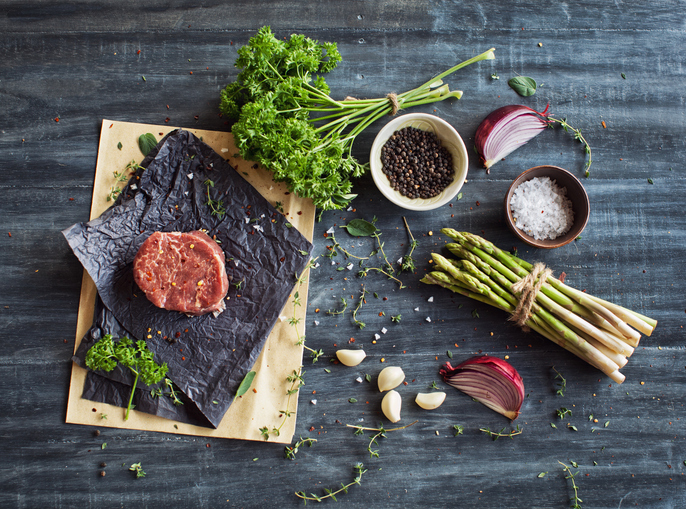What is the Paleo Diet Plan? A Beginner’s Guide

What is the Paleo diet?
Arguably, the Paleo diet is one of the “oldest” ways of eating. Simply put, it’s the antithesis of the modern Western-style diet. Essentially, it traces back to the diets of our ancestors from the Paleolithic era, which is far removed from current eating habits and food choices.
In its simplest form, the Paleo diet plan encourages eating whole, minimally processed foods you could hunt or forage in their most natural forms. Conversely, the standard Western-style diet is characterized by the overconsumption of heavily processed, refined foods. In other words, the Paleo diet may be summed up with slogans like “Eat REAL food” or “Don’t eat processed garbage.”
The History of the Paleo Diet Plan
In 1985, Drs. Stanley Boyd Eaton and Melvin Konner published a seminal article titled “Paleolithic Nutrition: A Consideration of Its Nature and Current Implications.”1 In the paper, they argued for the “Evolutionary Discordance” hypothesis, which paraphrased here states: human genes evolved to adapt to conditions that no longer exist. The change occurred too quickly for us to adapt. And the resulting mismatch helps cause some common chronic diseases, or “diseases of civilization.” These include:2
- Cardiovascular disease (e.g., atherosclerosis)
- Type 2 diabetes
- Chronic obstructive pulmonary disease (a disease of the lungs that interferes with normal breathing)
- Lung and colon cancers
- Hypertension (high blood pressure)
- Obesity
- Diverticulitis (a digestive disease)
- Cavities
As a fundamental basis for Evolutionary Discordance, they found “surprisingly little overlap” between foods of the Paleolithic era, which spans from approximately 2.6 million to ~10,000 years ago, and those of the current era, beginning with the introduction of agriculture and animal husbandry ~10,000 years ago. While 10,000 years may seem like a long time, it’s just a drop in the bucket in the grand scheme of things.
The Paleo Diet Plan vs The Contemporary Diet
Speaking generally, ancestral diets were characterized by much lower levels of refined carbohydrates and sodium and much higher levels of fiber and protein. Currently, most people get the majority of their calories from grains, refined vegetable/seed oils, domesticated livestock, dairy products, and refined sugars. On the other hand, hunter-gatherers ate naturally occurring plant foods (fruits, vegetables, nuts, and seeds), wild game, and fish. And they consumed virtually NONE of the following:1,3
- cereal grains
- refined sugars
- dairy foods
- separated oils
- commercially processed foods
- “empty calories”
Compared with the typical American diet, diets of the Paleolithic era generally provided:
- MORE protein
- MORE omega-3 fats
- LESS omega-6 fats
- LESS carbohydrate
- MORE fruits and vegetables
- LESS sodium
- MORE potassium
- MORE fiber
- MORE micronutrients
- MORE antioxidants and phytonutrients
More Benefits of Omega-3
According to Drs. Boyd Eaton and Konner, the qualitative differences between the “average” ancestral (hunter-gatherer) diet and the contemporary Western-style diet can be summarized as follows:2

The Pillars of the Paleo Diet Plan
While Dr. Boyd Eaton has been one of the most influential educators on ancestral diets, arguably no one has been more pivotal in bringing it to the mainstream than the “founder of the Paleo diet movement,” Dr. Loren Cordain. According to Dr. Cordain and other Paleo diet experts, these fundamental characteristics contribute to optimal health and weight management while minimizing risk of chronic disease:
- Increase protein intake by eating more lean meat, seafood, and eggs.
- Lower carbohydrate intake and lower glycemic index by eating primarily fresh fruits and vegetables, nuts, and seeds.
- Increase fiber intake by eating more fresh fruits and vegetables.
- Improve fat intake by cutting trans fats and omega-6 fats and eating more healthful monounsaturated and omega-3 fats.
- Increase potassium and lower sodium intake by eating primarily unprocessed, fresh foods.
- Increase intake of vitamins, minerals, antioxidants, and phytochemicals by eating more fresh fruits and vegetables and meat from pasture-raised animals.
- Reduce the acid load on the body by eating more alkaline-producing fresh fruits and vegetables.
- Eliminate cereal grains and legumes.
- Eliminate refined vegetable/seed oils.
- Eliminate added sugars, soft drinks, juice, and sweets.
- Eliminate dairy products.
- Eat when you’re hungry instead of counting calories.
Is the Paleo Diet for Weight Loss?
Despite the notion that it’s potentially the “oldest” diet around, a 2015 US News and World Report ranking of 35 diets placed the Paleo way of eating dead last, citing a lack of research evidence that showed clinical benefits.5 That said, several randomized, controlled trials have been published recently, providing a limited amount of evidence supporting the Paleo diet’s efficacy for weight management. Whether the evidence is robust enough to substantiate some of the extravagant claims, however, is a story for another day.
In a 3-month trial, researchers from Sweden found a small group of men and women lost significantly more weight (over 6 ½ more pounds) following the Paleo diet plan compared to a “heart-healthy” diet.6 The Paleo group also experienced significantly greater improvements in waist circumference, glycemic control, blood pressure, and blood lipids (e.g., cholesterol and triglycerides). A number of other short-term studies corroborate these findings, suggesting beneficial effects on body weight and metabolic function.7,8
In addition, a 2-year randomized, controlled trial with 70 obese women provides some interesting long-term insight. In the study, researchers found women on the Paleo diet lost significantly more weight (14.3 compared to 5.7 pounds) after 6 months compared to a traditional “heart-healthy” diet. After 2 years, the Paleo group had lost about 58% more weight, although the difference was not significant.9
Perhaps the most telling science (especially with a limited number of controlled trials) is what’s called a systematic review with meta-analysis, which examines the data from all the available studies. In one such review, researchers identified 4 clinical trials (involving 159 participants) that met their inclusion criteria. In all 4 trials, the Paleo diet resulted in significant weight loss and in 3 of the 4, that was compared to the control diet.5
It’s worth noting the review also found the Paleo diet resulted in greater improvements in the five risk factors for metabolic syndrome, which predispose people to type 2 diabetes and cardiovascular disease, including:
- Waist circumference
- Blood pressure
- Fasting blood glucose
- Fasting triglycerides
- Fasting HDL cholesterol
Overall, the quality of evidence is moderate that the Paleo diet plan has beneficial effects on body weight and metabolic function.
One particularly important point about most existing trials is that they did not impose calorie restriction. In other words, the participants were not told how much to eat (see principle #12 above). Thus, the Paleo diet may be particularly effective for weight management without calorie counting or portion-control measures. Indeed, researchers from Sweden have shown that the Paleo diet is more satiating than the Mediterranean-style diet and other “heart-healthy” diets.10
Supercharge Your Weight Loss:
The Foods on the Paleo Diet Plan
While many would like you to believe there’s a “one-size-fits-all” approach to the Paleo diet, the truth is there is arguably no single Paleolithic nutritional pattern. In fact, one of the greatest criticisms (and there are many) from anthropologists is there is simply no blanket prescription of an evolutionarily appropriate diet.11
As Drs. Boyd Eaton, Konner, and Cordain have pointed out in several publications, food choices are critically depended on the latitude and climate.1,3,4 In other words, depending on geographic location and season, the diets of our Paleolithic ancestors likely varied considerably in terms of composition and the proportion of plant-based foods compared to animal foods. Thus, a good rule of thumb is to eat locally grown food when it’s in-season.
Having said that, the following are typically considered “staples” of the Paleo diet plan:
- Unprocessed lean meats including beef, chicken, turkey, bison, lamb, pork, and wild game, preferably from pasture-raised or wild animals when possible
- Fish and shellfish, preferably wild-caught when possible
- Eggs, preferably from local, pasture-raised hens when possible
- All fresh vegetables (including root vegetables and various forms of squash), preferably local, in-season when possible
- All fresh fruits, preferably local, in-season when possible
- Nuts and seeds
- Healthful unrefined fats and oils including lard, tallow, ghee, butter, and olive, walnut, flaxseed, coconut, avocado, and macadamia oils
- Fresh and dried herbs and spices
- Small amounts of honey and vinegar for flavoring
- Water, water, and more water, preferably natural, local spring water when possible
While there may be some variability (by geographical location, environment, and season) in what our ancestors ate, there’s very little debate over what they DIDN’T eat. And along those lines, the following are “NO-NO’s” on a strict Paleo diet plan:
- Cereal grains
- Refined sugar
- Dairy
- Legumes (including beans and peanuts)
- Processed foods
- Refined vegetable oils
As far as macronutrient composition, there’s not a single agreed upon recommendation. However, protein is typically around 25 – 35%, fat between 30 – 40%, and carbohydrate between 25 – 40%. Overall, the Paleo diet may be described as high-protein, moderate-fat, and low- to moderate-carbohydrate.
Not Just a Diet
Any staunch proponent of the ancestral way of eating would tell you it’s far more than a diet. Paleo is a way of life, and that includes copious amounts of physical activity. Not surprisingly, it is estimated that hunter-gatherers expended upwards of FOUR to FIVE times as many calories as the average sedentary American.3,13
What does a hunter-gatherer fitness regimen look like? Here are some essential features:13
- Include copious amounts of light-to-moderate activity, including walking, chores, etc. It’s estimated that hunter-gatherers walked 3 – 10 miles a day.
- Carry weighted loads (backpacks, children, light weights, etc.) when walking if possible.
- Walk on soft, natural, uneven surfaces such as grass and dirt when possible.
- Walk barefoot or wear barefoot-mimicking shoes when possible.
- Perform interval training once or twice per week.
- Lift weights twice per week.
- Follow strenuous days (such as weight lifting or interval training) with a relatively easy day.
- Perform as much physical activity outdoors as possible.
- Exercise in a group/social setting when possible.
- Walk with a dog if possible.
- Dance!
- Engage in regular sexual activity.
- Make plenty of time for sleep, relaxation, and rest.
Eat like a caveman
There are several valid criticisms of the Paleo diet plan, including the argument that there is no single Paleolithic way of eating. (Ironically, there are at least a half-dozen variations of the Paleo diet.) To the credit of its founding fathers, however, the Paleo way of life encourages people to eat more REAL food (and less processed garbage), to move more, to spend more time outdoors, and to develop well-rounded social support. It’s hard to argue with that recipe when it comes to optimizing health, fitness, performance, and longevity.
That said, if your interest is piqued and you’re now considering the Paleo diet, that’s great! Now that you have some of the basics down, it’s time to take some next steps. Please post your questions or comments below, and we’ll be happy to help you get started.
Supercharge Your Diet Results with IC-5
IC-5, which is scientifically-designed to promote insulin sensitivity and improved carb tolerance, is one of our top diet-boosting supplement.
With IC-5, you know that you are supporting carbohydrate tolerance, keeping potentially harmful AGEs at bay, and amplifying the anti-aging effects of the ketogenic diet. It’s a triple threat for overall health and anti-aging!









